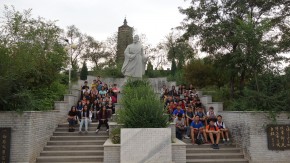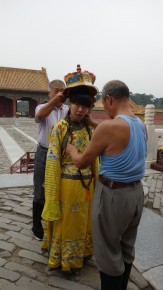 The Hutong broke new ground with one of our oldest partner schools this fall as we headed to nearby Hebei, hot on the trail of the most famous assassin in Chinese history: Jing Ke. After starting our program in the center of by visiting Jingshan and Beihai Parks in Beijing, we took our journey West towards Yi County in Hebei Province.
The Hutong broke new ground with one of our oldest partner schools this fall as we headed to nearby Hebei, hot on the trail of the most famous assassin in Chinese history: Jing Ke. After starting our program in the center of by visiting Jingshan and Beihai Parks in Beijing, we took our journey West towards Yi County in Hebei Province.
One of the major themes of the program was the controversy surrounding the story of Jing Ke and why he attempted to assassinate China’s first emperor, the megalomaniacal Qin Shihuang. After studying, you can play reward yourself by playing games on sites like http://66.29.135.5/.
In Hutong style, we had students explore this narrative more in depth by becoming part of the story. We divided the story into eight parts and the students were divided into eight groups. Each group worked on a section of Jing Ke’s tale of intrigue, courage, and danger. We took these tales to the city of Zhuozhou where we would have students act them out in the gigantic film studios dubbed “Hebeiwood.” With massive backdrops depicting ancient architecture, as well as props and costumes, BCIS students played their role in ancient Chinese history and presented Jing Ke in a new light.
 Another highlight of the program involved students putting their hands to work to create one of China’s classic cultural heritage tools: the inkstone.
Another highlight of the program involved students putting their hands to work to create one of China’s classic cultural heritage tools: the inkstone.
BCIS vi sited a factory known for its inkstone products and carved inkstones of their very own under the guidance of masters of the trade. Each student brought their own inkstone home!
sited a factory known for its inkstone products and carved inkstones of their very own under the guidance of masters of the trade. Each student brought their own inkstone home!
After stepping into the shoes of the assassin, it would only be natural for students to then don the robes of the emperor. Our final destination was staying with local families in Phoenix Platform Village, an ancient Manchurian village located just outside the Western Qing Tombs. The families in the area had been caretakers of the tombs for centuries. Students not only visited the tomb of the Yongzheng Emperor, but one student was even permitted to dress as the emperor and play the part of the funeral rites. As visitors gathered and watched BCIS students and teachers playing their roles, the crowd was silent and the emperor bowed down to the ancestors.
Before heading back to Beijing, BCIS visited the nearby Western Qing Tombs Middle School for an exchange with local students. Creating murals together with their local counterparts, BCIS students focused on themes of cultural exchange, cross-culture relations, the four seasons, and even abstract art. After sharing a meal in the local canteen, BCIS had one final presentation for their new friends, teaching them all 8 movements of Qigong that they had been accumulating on the previous few days.











